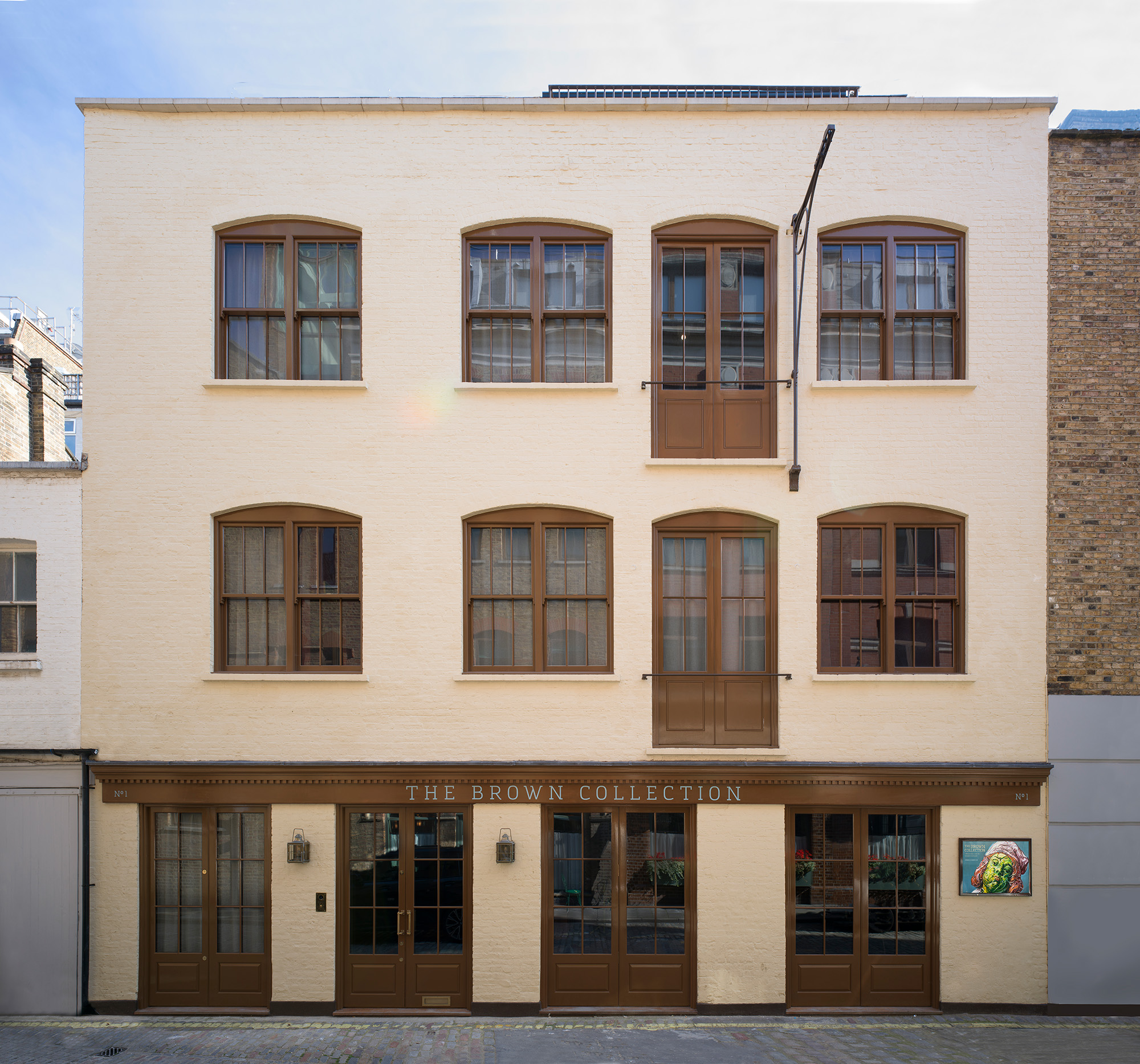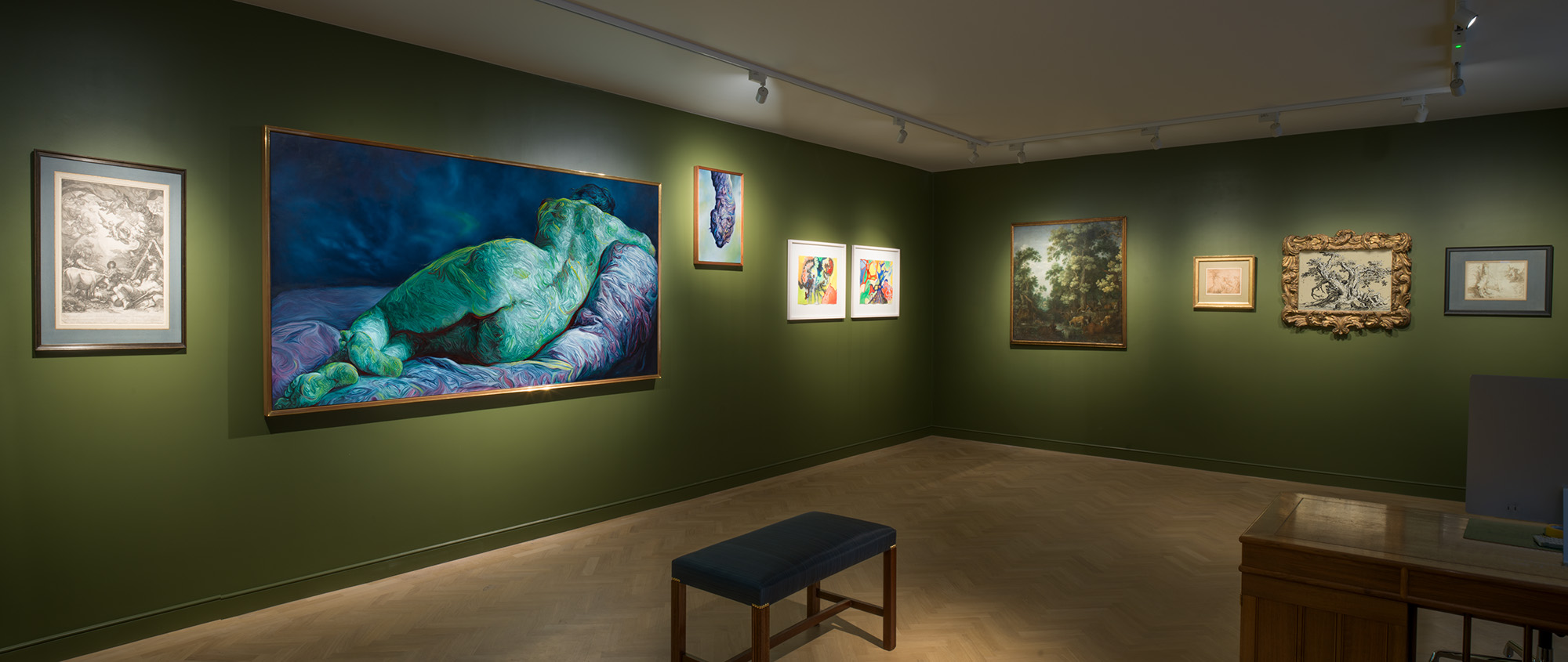The Brown Collection: a new gallery drawing from the past
A new gallery in central London presents the work of
celebrated artist Glenn Brown with his own personal collection of historical
art. Set on a Marylebone mews street, the former furniture workshop and showroom
has been meticulously renovated into The Brown Collection.
Central to the work of Glenn Brown is a reflection upon art history and
references to great works which went before – sometimes through a playful
reinterpretation, sometimes as an identical reproduction, and sometimes as
nightmarish transmogrification. A self-described
appropriation artist, the practice he has developed since graduating from his MFA at Goldsmiths
College in 1992, has seen him rise into the position of a widely-exhibited and
collected artist, with works in auction selling well into seven figures.
![]()
![]()
![]()
This success has allowed him to indulge in his own collecting – of art, but also architecture. Already with a newly renovated historic home and studio on the Suffolk coast, the artist has just opened the doors to a five-storey former furniture workshop and showroom, now transformed into The Brown Collection – a free-to-visit display of the artist’s own work shown amongst his personal collection.
The artist was very hand’s on with the four-year refurbishment of the building, wanting it to read as if nothing had been done to the space for visitors walking in off Bentinck Mews, the street it sits on, and to restore the building to its 1905 integrity. But there are some subtle tweaks. A row of three windows and former-delivery doors on the first and second floors can be read from the outside, but internally within the new gallery spaces a new wall runs in front with a shallow profile to suggest the window now covered up – the new wall curtains and lighting designed such so that the new wall does not impact how the façade is read externally at night time.
![]()
![]()
![]()
The former basement coal store, which runs under the road, has become a neat sculpture gallery with the rough stucco wall texture kept to provide contrast to the three floors of more formal display spaces upstairs. At the very top is an office for Brown and his management, with rooftop views across Marylebone.
![]()
![]()
![]()
The work on display is set to change periodically, with Brown keen to present historic artists he feels are not known about enough, such as Austin Osman Spare (1886-1956) and Grace Pailthorpe (1883-1971), both included in the space’s first hang. While the curation and function of the gallery space may well develop as time passes, this first show – titled The Leisure Centre– launches to coincide with Frieze London 2023, offering thematic connections between Gagosian-represented Brown’s work and others, as well as comparison studies to see where his influences are drawn from.
![]()



Figs.i-iii
This success has allowed him to indulge in his own collecting – of art, but also architecture. Already with a newly renovated historic home and studio on the Suffolk coast, the artist has just opened the doors to a five-storey former furniture workshop and showroom, now transformed into The Brown Collection – a free-to-visit display of the artist’s own work shown amongst his personal collection.
The artist was very hand’s on with the four-year refurbishment of the building, wanting it to read as if nothing had been done to the space for visitors walking in off Bentinck Mews, the street it sits on, and to restore the building to its 1905 integrity. But there are some subtle tweaks. A row of three windows and former-delivery doors on the first and second floors can be read from the outside, but internally within the new gallery spaces a new wall runs in front with a shallow profile to suggest the window now covered up – the new wall curtains and lighting designed such so that the new wall does not impact how the façade is read externally at night time.



Figs.iv-xi
The former basement coal store, which runs under the road, has become a neat sculpture gallery with the rough stucco wall texture kept to provide contrast to the three floors of more formal display spaces upstairs. At the very top is an office for Brown and his management, with rooftop views across Marylebone.



Figs.xii-ix
The work on display is set to change periodically, with Brown keen to present historic artists he feels are not known about enough, such as Austin Osman Spare (1886-1956) and Grace Pailthorpe (1883-1971), both included in the space’s first hang. While the curation and function of the gallery space may well develop as time passes, this first show – titled The Leisure Centre– launches to coincide with Frieze London 2023, offering thematic connections between Gagosian-represented Brown’s work and others, as well as comparison studies to see where his influences are drawn from.

Fig.x
Glenn Brown, CBE, (born 1966) is a British artist. He is
known for the use of art historical references in his paintings. Starting with
reproductions from other artist's works, Brown transforms the appropriated
image by changing its colour, position, and size. His grotesque yet fascinating
figures appear to be painted with thick impasto, but are actually executed
through the application of thin, swirling brushstrokes which create the
illusion of almost photographically flat surfaces. The effect is powerful-often
unsettling creating an artistic language that transcends time and pictorial
conventions. Brown sees these appropriations and oppositions as key to his
approach.
Brown also places sculpture as a central point of his
practice. They are created by accumulating thick layers of oil paint over
structures or found bronze casts. His sculptures, deliberately emphasising the
three-dimensional quality of oil brushstrokes, stand in stark contrast to his
flat paintings. The forms of his sculptures and the colour combinations used
reference other artists' paintings and sculptures.
In the last few years, Brown has extensively embraced
drawing. Still conceptually rooted to art historical references, he stretches,
combines, distorts and layers images to create subtle yet complex
line-based works.
www.glenn-brown.co.uk
visit
The
Brown Collection is at 1 Bentinck Mews, London, open Thursdays to Saturdays,
11am – 6pm with free admission. Further information available at:
www.glenn-brown.co.uk/the-brown-collection
images
fig.i Glenn Brown,
Reproduction (2014).
Oil on panel,
135 x 101 cm. Photograph ©
Rob McKeever.
fig.ii Glenn Brown,
Bikini (2022).
Oil on panel,
200 x 140.9 cm.
Photograph © Lucy Dawkins.
fig.iii Glenn Brown,
The Real Thing (2000).
Oil on panel,
82 x 66.5 cm.
Photograph © The Brown Collection.
figs.ix-xi,x The Brown Collection. Photographs © The Brown Collection.
fig.vii Cornelius Van Haarlem
(Dutch 1562–1638), Head of a woman (1629).
Oil on panel,
37.5 x 28.8 cm.
Photograph © The Brown Collection.
fig.viii Mauro Gandolfi (Italian 1764–1834), Head studies of an old man and a young boy. Pen and brown ink on laid paper laid on card, 14.4 x 20.7 cm. Photograph © The Brown Collection.
fig.ix Henri Fantin-Latour
(French 1836–1904),
Manfred et Astarte. Oil on canvas,
55.9 x 45.8 cm. Photograph © The Brown Collection.
publication date
02 October 2023
tags
Appropriation, Basement, Gallery, Glenn Brown, Henri Fantin-Latour, Frieze London, Gagosian, Mauro Gandolfi, Marylebone, Mews, Museum, Austin Osman Spare, Painting, Grace Pailthorpe, Renovation, Sculpture, The Brown Collection, Cornelius Van Haarlem
www.glenn-brown.co.uk/the-brown-collection


